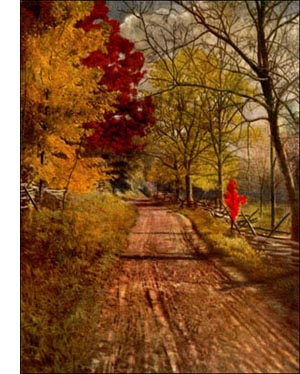Pignut or White Hickory Tree
 Pignut, White Hickory (Hicoria glabra, Britt.)-A stately, round-headed tree, 50 to too feet high, with narrow head of pendulous contorted branches. Bark grey, coarse, rough, not scaling off in plates. Wood brown, tough, elastic, hard, heavy. Buds terminal ones, globular, blunt, shedding outer scales early in winter; inner scales expand, and recurve as leaves unfold; lateral buds small, pointed. Leaves alternate, 8 to 12 inches long, oddpinnate, of 5 to 7 leaflets, oblong or obovate-lanceolate, smooth, dark yellow-green; lighter and sometimes tufted with hairs in axils of veins beneath; upper leaflets much larger than lower ones. Flowers: staminate catkins, axillary, 4 to 7 inches long, in threes; pistillate spikes, 3 to 5-flowered, terminal, greenish. Fruit pear shaped, or globose; variable, thick or thin shelled, reddish brown, somewhat hairy, cleft into q4 valves, partially or wholly opening; nut obscurely 4-angled, smooth; kernel sweet or slightly bitter, small. Preferred habitat, dry ridges and hillsides. Distribution, Maine to Florida; west through Ontario and Michigan to Nebraska, south to eastern Texas. Uses: Wood used as that of shagbark is. A valuable ornamental and shade tree.
Pignut, White Hickory (Hicoria glabra, Britt.)-A stately, round-headed tree, 50 to too feet high, with narrow head of pendulous contorted branches. Bark grey, coarse, rough, not scaling off in plates. Wood brown, tough, elastic, hard, heavy. Buds terminal ones, globular, blunt, shedding outer scales early in winter; inner scales expand, and recurve as leaves unfold; lateral buds small, pointed. Leaves alternate, 8 to 12 inches long, oddpinnate, of 5 to 7 leaflets, oblong or obovate-lanceolate, smooth, dark yellow-green; lighter and sometimes tufted with hairs in axils of veins beneath; upper leaflets much larger than lower ones. Flowers: staminate catkins, axillary, 4 to 7 inches long, in threes; pistillate spikes, 3 to 5-flowered, terminal, greenish. Fruit pear shaped, or globose; variable, thick or thin shelled, reddish brown, somewhat hairy, cleft into q4 valves, partially or wholly opening; nut obscurely 4-angled, smooth; kernel sweet or slightly bitter, small. Preferred habitat, dry ridges and hillsides. Distribution, Maine to Florida; west through Ontario and Michigan to Nebraska, south to eastern Texas. Uses: Wood used as that of shagbark is. A valuable ornamental and shade tree.The pignut is unfortunate in its common name. A fine park and shade tree is under a severe handicap. For who would wish a "pignut" planted in his front yard? A "smooth hickory" will rather be chosen, every time-though it is the very same tree, H. glabra. In the early days pigs turned into the autumn woods crunched these hickory nuts which nutters, looking for shellbarks, scornfully left under the trees. The insipid meats were distasteful to human palates-fit only for pigs.
Yet here is one of the finest of the hickories. Its bark is close textured like that of a white ash. Its leaves and shoots soon lose their down and become smooth and lustrous. The small winter buds are ovate, and during autumn their outer scales drop. The nuts are roundish and smooth shelled. The thin husks split but half way down, and are there grown fast to the shell. These characters mark the typical Eastern pignut. West of the Alleghanies is a form that sheds its husks, and has angled, ovoid nuts. The bark of this variety-odorata-is rough, like an American elm, but not shaggy.
Variety microcarpa is a pignut with bark of the H. ovala type, stripping into narrow, thin, springy sheets. The roundish nut is white or grey, and thin shelled. The kernel is sweet. There are reasons for believing this to be a natural hybrid between H. ovata and H. glabra. Its branches are likely to be pendulous, and the head more oblong than the ordinary pignut. I t is commonly called "false shagbark."
The extreme variability of the species glabra, and the good quality of fruit in var. microcarpa make horticulturists believe that the pignut is worthy of cultivation. Experiments are now in progress looking toward the improvement of the fruit for commercial purposes. The signs are hopeful.
With wood equal to the best in its genus, exceptional merits as a shade and ornamental tree, and promise of developing orchard varieties that will rival the shagbarks as nut trees, the pignuts seem to be one of the "coming trees" in the Eastern States. It is to be hoped that the popular name will be abandoned and the more suitable one, "smooth hickory," substituted. This is a literal translation of its scientific name.